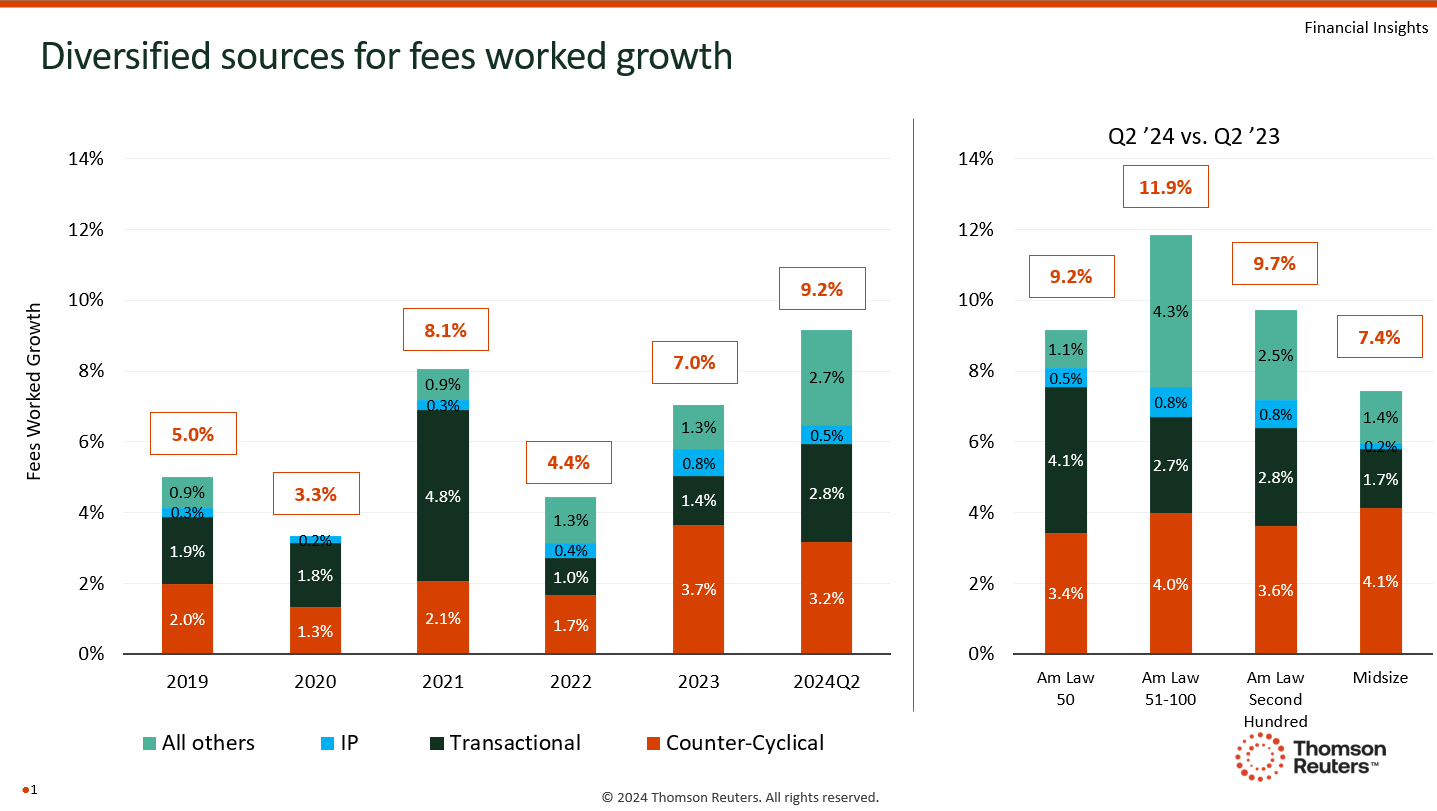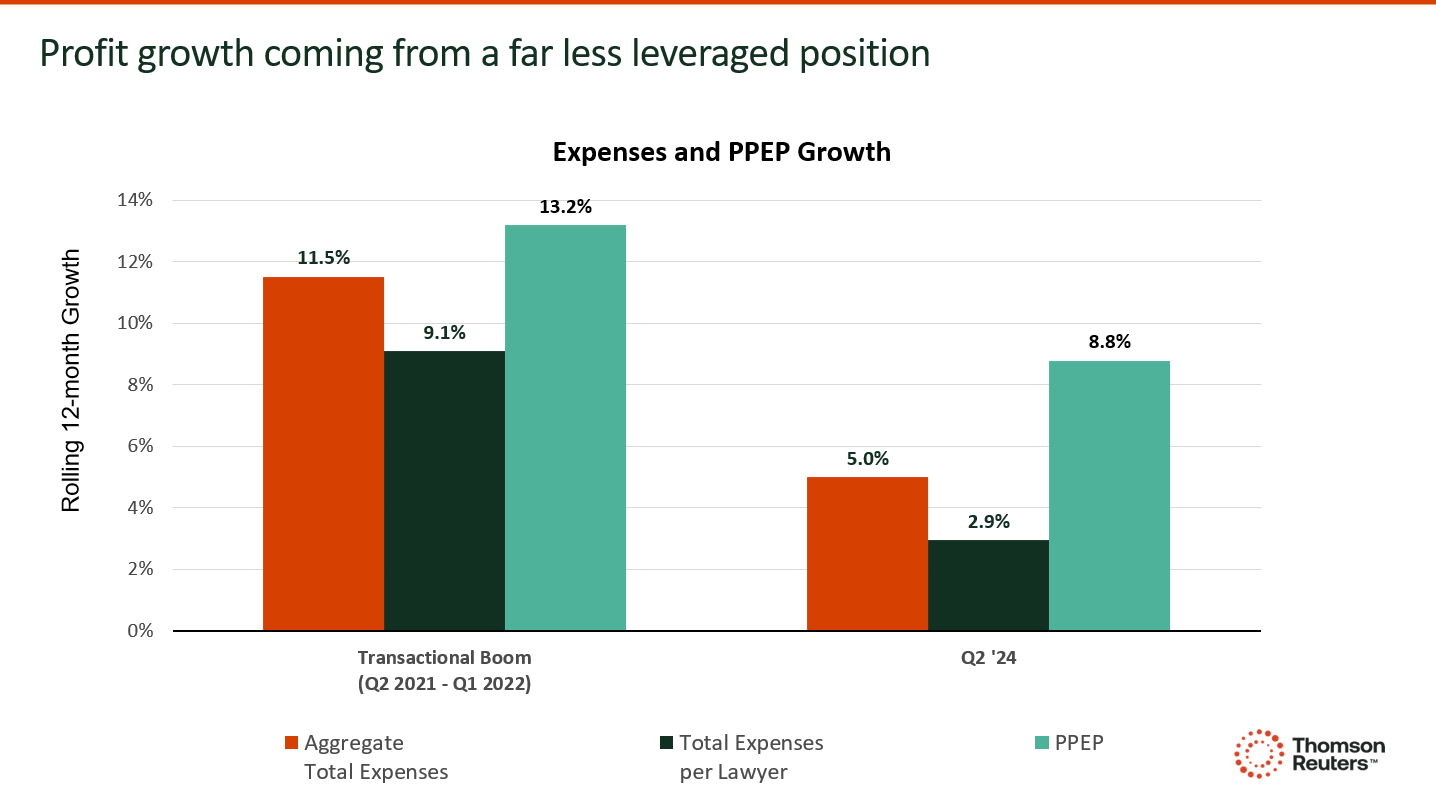What role did diversified streams of legal demand among practice areas play in producing law firms’ fastest growth in fees worked since the Global Financial Crisis?
In the second quarter of this year, law firms demonstrated robust performance — as shown in the recent Thomson Reuters® Institute Q2 Law Firm Financial Index report — that was reminiscent of the transactional boom era of a few years previous, a period in which total profits experienced double-digit growth. This significant improvement in Q2 2024 results can be largely attributed to the impressive increase in fees worked — a pre-realization proxy for revenue — in which firms saw a remarkable 9.2% increase quarter-over-quarter.
This surge, excluding the exceptional second quarter of 2021 when growth was being compared against pandemic-induced lows, marks the fastest pace of growth in fees worked since we’ve been compiling this data. Essentially, this makes Q2 2024 the fastest growing organic fees worked total since the Global Financial Crisis of 2007-‘08.
Indeed, this uptick in fees worked substantially contributed to an 8.8% growth in profits per equity partner (PPEP) on a rolling 12-month basis, placing firms in an enviable position through the first half of this year.
Diversification safeguards against volatility
One of the most striking aspects of this past quarter’s performance is the diversification of fees worked growth across various practice areas. The chart below shows the impact on overall fees by each practice grouping, with weighted growth shown by the proportion that each practice group comprises of total fees. Unlike the previous revenue boom of 2021-‘22, in which growth was predominantly driven by transactional work, the current landscape showcases a more balanced growth pattern.
The average firm in Q2 2024 witnessed nearly equal growth in fees across transactional, counter-cyclical, and other practice areas such as regulatory, trusts & estates, and environmental law. Specifically, transactional work contributed 3.2 percentage points of the total 9.2% growth, counter-cyclical practices added 2.8 points, and other areas accounted for 2.7 points. This diversification places law firms in a position today in which they can potentially thrive irrespective of typical economic cycles.

As seen on the right side of the chart, firms in the Am Law 51-100 and Am Law Second Hundred segments are prime examples of how fees worked growth in Q2 has come from a diversified practice mix, enhancing firms’ resilience to market fluctuations. Should there be a decline in either transactional demand or counter-cyclical work, as has happened in the past, many firms will be well positioned to sustain their performance due to their balanced portfolio of revenue streams.
That said, of course, there are notable exceptions within specific segments of firms. Midsize firms, for example, are experiencing the majority of their demand and fees worked growth from counter-cyclical practices, particularly litigation. This heavy reliance on a single practice area could pose risks if demand shifts. Additionally, firms within the Am Law 50 are exhibiting another focused strategy, relying heavily on transactional practices which made up 45% (4.1 percentage points of their overall 9.2% growth) of their total fees growth in the second quarter.
While this more leveraged strategy may yield multiplied success during favorable market conditions, it also poses significant risks during downturns. If anything happens to transactional fees, the Am Law 50 firms are going to lose their key source of growth and could see their PPEP growth lose its positive trajectory. Similarly, those Midsize law firms heavily reliant on counter-cyclical practices like litigation could face substantial challenges if demand in these areas wanes.
Enjoying a more stable position
Overall, however, the average law firm is currently in a more stable financial position from a revenue and expense perspective as well, when compared to the same 2021 short-lived period of prosperity in 2021-‘22. Through the second quarter of this year, firms have managed to control their expenses more effectively than during the previous revenue surge, and by doing so, they have thus far avoided carrying the potential burden of rapidly escalating costs should the pace of top-line revenue slow.

It appears that firms have learned from past experiences, particularly since the transactional boom, and have adopted more prudent expense management practices both in aggregate and on a per-lawyer basis. While firms are only increasing their PPEP by 8.8% compared to the 11.5% figures seen during the transactional boom, firms are not having to pay nearly as much for that growth either. Total expenses are increasing by 5.0% and per lawyer costs are increasing by 2.9%; while these figures can be improved on, they are far lower than what was seen during the transactional boom when both aggregate and per lawyer expenses were growing at nearly double digits.
Should revenue begin to slide, firms will not be left paying the exorbitant bill they were left with last time.
In conclusion, the second quarter of 2024 has showcased a balanced and strategic approach to both revenue generation and expense management among all strata of law firms. The impressive 9.2% growth in fees worked highlights the sector’s adaptability and multifaceted growth across various practice areas, ensuring that firms can navigate different economic conditions and an uncertain future. This prudent approach is mirrored in the careful control of expenses, which are significantly lower than during the previous boom.
The varying strategies of different firm segments — such as the Am Law 50’s focus on transactional work and Midsize firms’ reliance on counter-cyclical practices — underscore the diverse paths to success. However, it may also demonstrate a strategic leaning in on strengths that can suggest some acceptance of greater volatility in performance.
More broadly, the average firm’s skill in maintaining a balanced approach will be crucial in its ability to capitalize on future opportunities and mitigate potential challenges, thus ensuring continued growth and resilience in an ever-evolving legal market landscape.
You can download a full copy of the Thomson Reuters® Institute Q2 Law Firm Financial Index report here.







